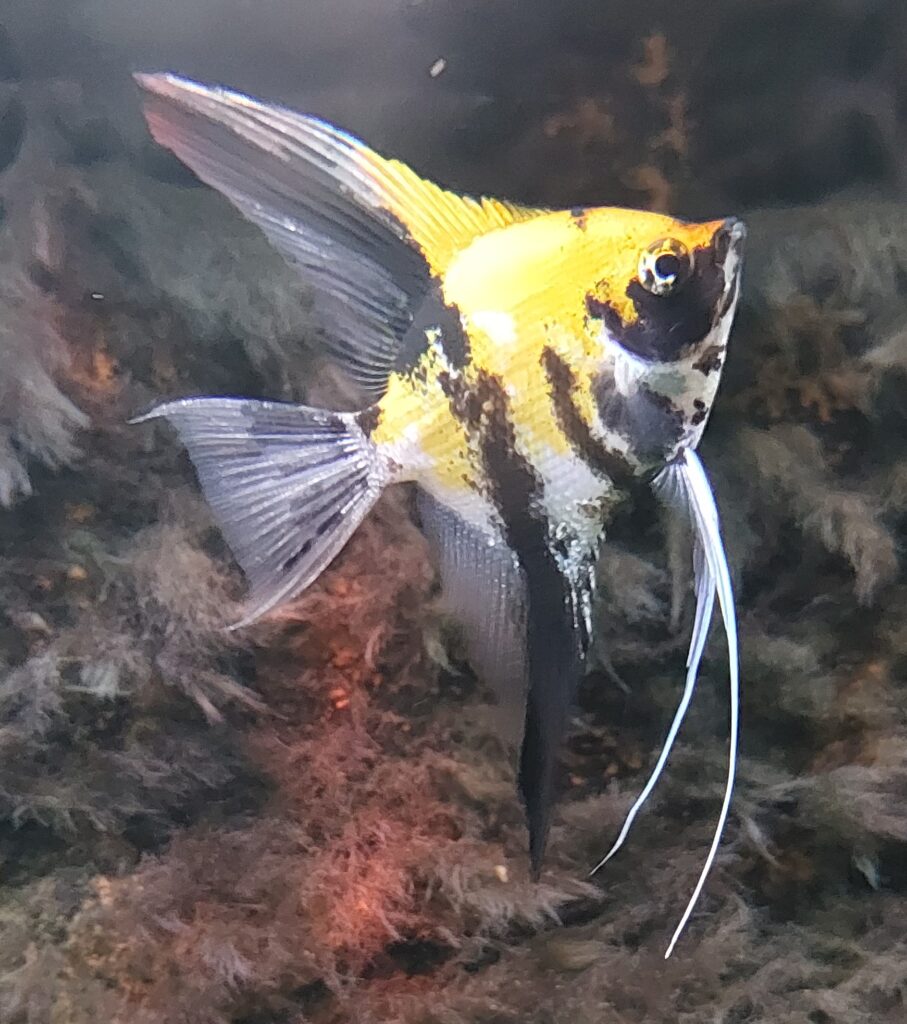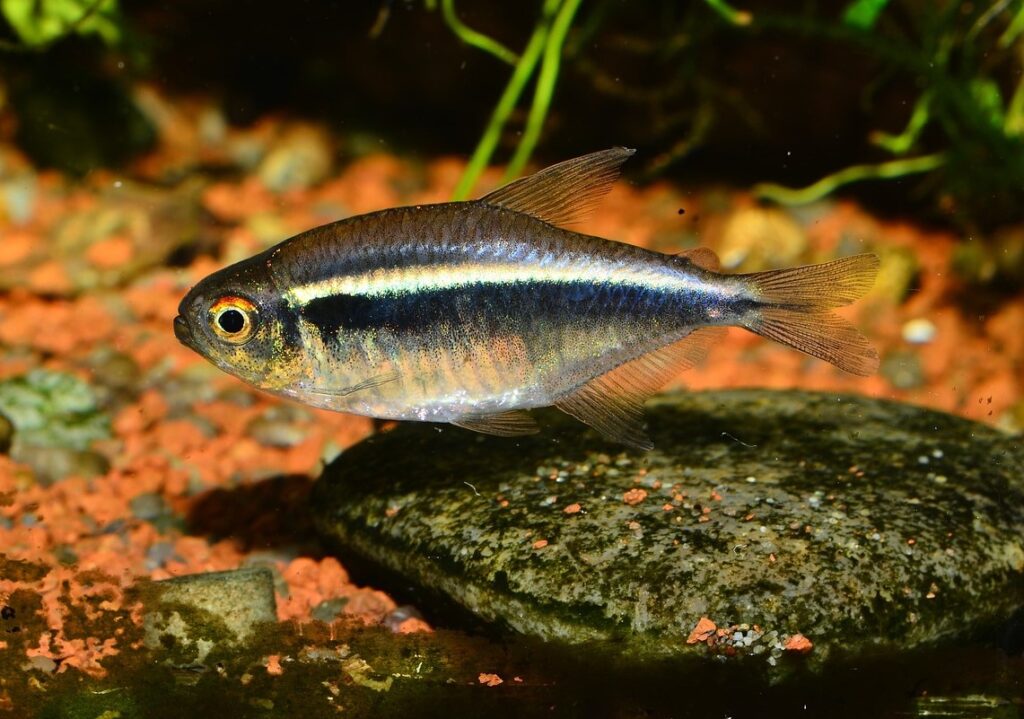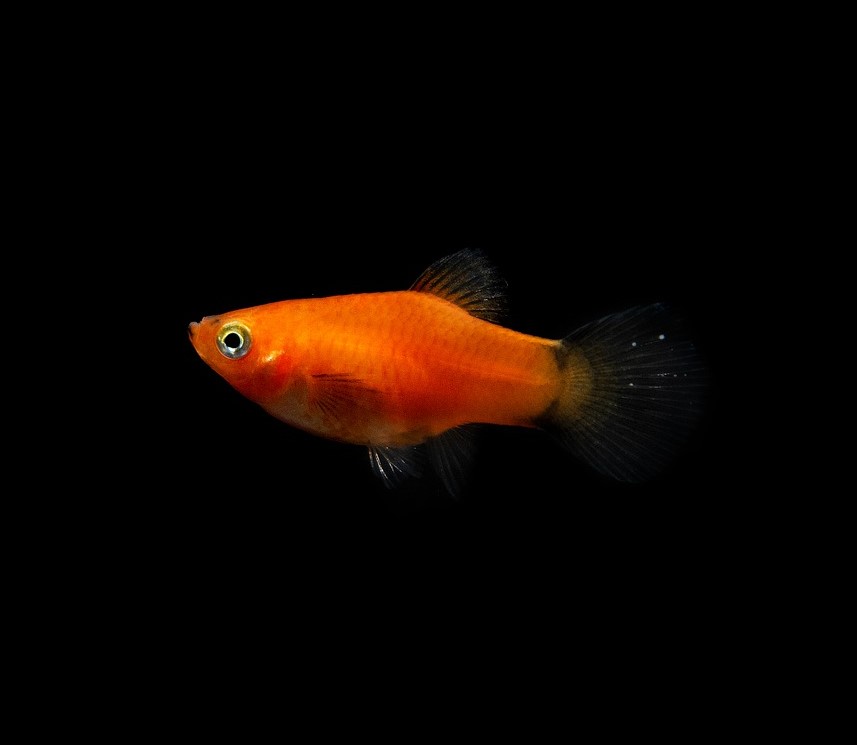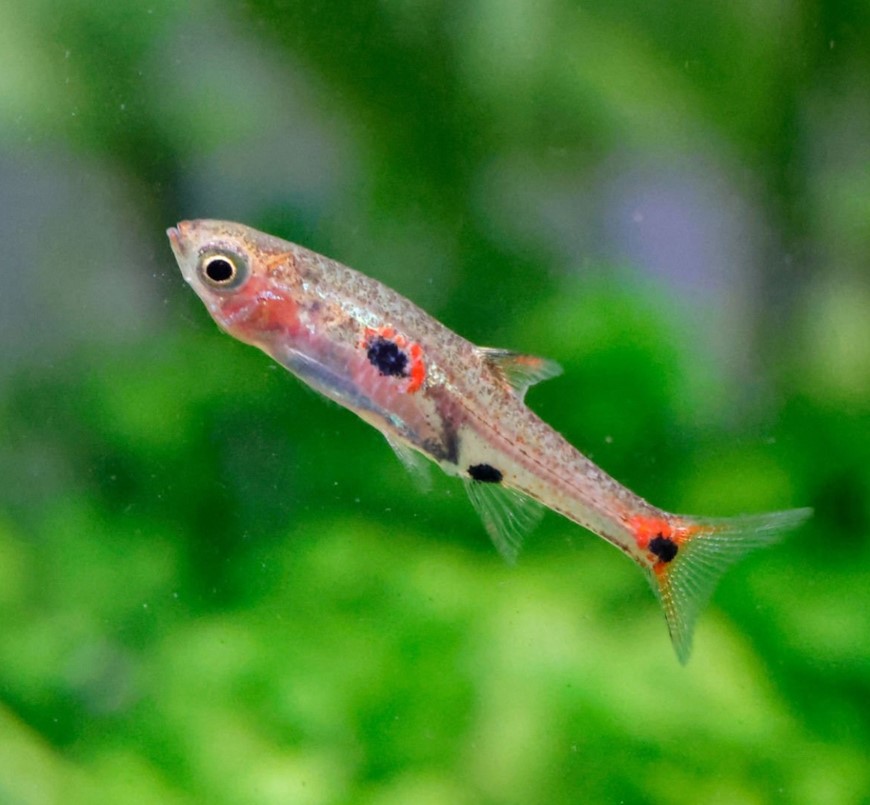Welcome
Discover the fascinating world of tropical freshwater fish, perfect companions for your aquarium. These vibrant fish bring color, life and joy to your living space. Understanding their living conditions is critical to creating a healthy aquatic environment. From the elegant angelfish to the lively guppies: each species has specific needs in terms of water conditions and temperature. Dive into our guide to learn more about how to provide the best care for your aquatic friends.
Angelfish

The sunfish is a popular fish known for its distinctive shape and vibrant colors. It prefers slightly acidic water with a pH value of 6.5-7.5 and a temperature between 25-28°C. Angelfish can be kept in a community aquarium, but be careful with their size and possible terretorial behavior.
- Lifespan: 10 years
- Feeding Habits: Angelfish are omnivores and can be fed a diet of flakes, pellets, and live or frozen foods.
- Length: Approximately 15 cm
- Gender: Males and females have distinct characteristics.
- Habitat: Amazone region

Guppy

Guppies are small, colorful fish that are easy to care for and perfect for beginners. They thrive in a pH range of 7.0-8.0 and a temperature between 24-26°C. Guppies are known for their lively personalities and can be kept in a community aquarium.
- Lifespan: 1-2 years
- Feeding Habits: Guppies are omnivores and can be fed a diet of flakes, pellets, and small live or frozen foods.
- Length: Approximately 3 cm
- Gender: Males are smaller with colorful tails, while females are larger and less colorful.
- Habitat: South America

Betta

Betta, also called Siamese fighting fish, with vibrant colors and flowing fins. They prefer slightly acidic water with a pH value of 6.8-7.8 and a temperature between 25-27°C. Betta fish are territorial, so it is essential to keep them in an adequately sized aquarium.
- Lifespan: 2-4 years
- Feeding Habits: Bettas are carnivores and prefer a diet of pellets, live or frozen foods.
- Length: Approximately 6 cm
- Gender: Males have larger fins and more vibrant colors compared to females.
- Habitat: Southeast Asia, namely Cambodia, Laos, Myanmar.

Tetra

Tetras are schooling fish that like to be kept in an aquarium. They do well in a pH range of 6.5-7.5 and a temperature between 24-27°C. Tetras are peaceful and can be kept in a community aquarium with other non-aggressive species.
- Lifespan: 5-10 years
- Feeding Habits: Tetras are omnivores and can be fed a varied diet including flakes, pellets, and small live or frozen foods.
- Length: Approximately 5 cm
- Gender: Difficult to distinguish, but females may be slightly larger and rounder.
- Habitat: South America

Corydoras Catfish

Corydoras catfish are bottom dwellers known for their friendly nature. They thrive in a pH range of 6.5-7.5 and a temperature between 22-26°C. Corydoras are social and should be kept in groups. They are great soil cleaners.
- Lifespan: 5-7 years
- Feeding Habits: Corydoras are omnivores and can be fed sinking pellets, flakes, and small live or frozen foods.
- Length: Approximately 7 cm
- Gender: Females may be larger and rounder, especially when carrying eggs.
- Habitat: South America

Molly

Mollies come in a variety of colors and are known for their peaceful behavior. They prefer a pH range of 7.5-8.5 and a temperature between 24-27°C. Mollies can be kept in a community aquarium. Mollies are a cultivated species.
- Lifespan: 3-5 years
- Feeding Habits: Mollies are omnivores and can be fed a diet of flakes, pellets, and small live or frozen foods.
- Length: Approximately 5 cm
- Gender: Males may have a modified anal fin (gonopodium) and females may be larger and have a rounded anal fin.
- Habitat: Mexico to Colombia

Rasbora

Rasboras are peaceful schooling fish with bright colors. They prefer slightly acidic water with a pH range of 6.0-7.0 and a temperature between 24-28°C. Rasboras should be kept in groups for their well-being.
- Lifespan: 5-8 years
- Feeding Habits: Rasboras are omnivores and can be fed a diet of small live or frozen foods, as well as flakes and pellets.
- Length: Approximately 4 cm
- Gender: Males may be smaller and more colorful, while females may be larger and rounder.
- Habitat: Myanmar

Cichlid

Cichlids come in different types, each with unique characteristics. They have specific water preferences depending on the species. It is essential to research the specific strain you have. Some cichlids prefer slightly acidic to alkaline water with a pH of 6.0-8.0 and a temperature between 21-26°C.
- Lifespan: Varies by species
- Feeding Habits: Cichlids are omnivores, and their diet varies by species. Provide a balanced diet of pellets, flakes, and occasional live or frozen foods.
- Length: Varies by species
- Gender: Varies by species
- Habitat: Africa and South America

Platy

Platies are colorful and easy to care for fish. They prefer slightly alkaline water with a pH value of 7.0-8.0 and a temperature between 23-26°C. Platies are social and can be kept in community tanks.
- Lifespan: 3-5 years
- Feeding Habits: Platies are omnivores and can be fed a diet of flakes, pellets, and small live or frozen foods.
- Length: Approximately 5 cm
- Gender: Males have a gonopodium, and females are larger with a fan-shaped anal fin.
- Habitat: Central America and southern Mexico.

Rainbowfish

Rainbowfish are known for their colors and peaceful nature. They thrive in slightly acidic to alkaline water with a pH range of 6.5-7.5 and a temperature between 23-28°C. Rainbowfish should be kept in groups.
- Lifespan: 5-8 years
- Feeding Habits: Rainbowfish are omnivores and can be fed a diet of flakes, pellets, and small live or frozen foods.
- Length: Varies by species, generally between 5-10 cm
- Gender: Males may have more intense colors, and females may be slightly larger.
- Habitat: Papua New Guinea and north-east Australia

Discus

Discus fish are prized for their stately colors and unique disc-like shape. They prefer soft and acidic water with a pH value of 6.0-7.0 and a temperature between 28-30°C. Discus fish are best kept in an aquarium specially designed for them with only conspecifics.
- Lifespan: 10-15 years
- Feeding Habits: Discus are omnivores and can be fed a diet of high-quality pellets, flakes, and occasional live or frozen foods.
- Length: Approximately 20 cm
- Gender: Difficult to distinguish, usually observed during breeding behavior.
- Habitat: Amazon river basin in Brazil

Zebra Danio

Zebra Danios are small and active schooling fish. They do well in slightly acidic to alkaline water with a pH range of 6.0-7.0 and a temperature between 18-23°C. Zebra danios are social and do best in larger schools.
- Lifespan: 3-5 years
- Feeding Habits: Zebra Danios are omnivores and can be fed a diet of flakes, pellets, and small live or frozen foods.
- Length: Approximately 5 cm
- Gender: Females may be slightly plumper, especially when carrying eggs.
- Habitat: South-East Asia

Gourami

Gouramis are labyrinth fish known for their unique fin shapes and labyrinth organ. They prefer slightly acidic to alkaline water with a pH range of 6.0-7.5 and a temperature between 22-28°C. Gouramis can be kept in a community tank, but males may exhibit territorial behavior.
- Lifespan: 4-6 years
- Feeding Habits: Gouramis are omnivores and can be fed a diet of flakes, pellets, and small live or frozen foods.
- Length: Varies by species, generally between 5-15 cm
- Gender: Males may have longer fins, brighter colors, and a more pointed dorsal fin.
- Habitat: South-East Asia

Swordtail

Swordtails are active fish known for their distinctive sword-like tails. They thrive in slightly alkaline to moderately alkaline water with a pH range of 7.0-8.4 and a temperature between 22-26°C. Swordtails are viviparous animals, meaning they give birth to free-swimming young instead of laying eggs.
- Lifespan: 3-5 years
- Feeding Habits: Swordtails are omnivores and enjoy a varied diet of flakes, pellets, and small live or frozen foods.
- Length: Adults typically reach lengths of 6-8 centimeters (2.5-3 inches).
- Gender: Males display a longer and more prominent sword-like extension on their tails, while females have a rounder abdomen.
- Habitat: Central America

Bristlenose Pleco

Bristlenose Plecos, also known as bushynose or Ancistrus, is a popular algae-eating catfish with a bristly appearance. They prefer slightly acidic to slightly alkaline water with a pH range of 6.5-7.5 and a temperature between 21-27°C.
- Lifespan: 10-15 years
- Feeding Habits: Bristlenose Plecos are herbivores and primarily feed on algae wafers and fresh vegetables.
- Length: Adults typically grow to lengths of 10-15 centimeters (4-6 inches).
- Gender: Male Bristlenose Plecos often have more prominent bristles on their heads and are generally smaller than females.
- Habitat: South America

Killifish

Killifish are fascinating, vibrant fish with diverse colors and unique reproductive habits. They prefer slightly acidic to neutral water with a pH range of 6.0-7.0 and a temperature between 22-26°C. Killifish are best kept in single-species tanks due to their territorial nature.
- Lifespan: 1-3 years
- Feeding Habits: Killifish are carnivores and primarily feed on live foods such as small insects and freeze-dried foods.
- Length: Adults vary in length depending on the species, with most ranging from 3-8 centimeters (1.2-3 inches).
- Gender: Male Killifish often display more vibrant colors and may have longer fins compared to females.
- Habitat: almost anywhere, except Australia and Antarctica

Cherry Barb

Cherry Barbs are small, peaceful fish with a red color, making them a popular choice for community aquariums. They thrive in slightly acidic to slightly alkaline water with a pH range of 6.0-7.5 and a temperature between 24-27°C.
- Lifespan: 4-5 years
- Feeding Habits: Cherry Barbs are omnivores and enjoy a varied diet of flakes, pellets, and small live or frozen foods.
- Length: Adults typically reach lengths of 4-5 centimeters (1.6-2 inches).
- Gender: Males often display more intense red coloration and may have slightly longer fins compared to females.
- Habitat: Sri Lanka

Harlequin Rasbora

Harlequin Rasboras are peaceful schooling fish prized for their remarkably active behavior. They prefer slightly acidic to neutral water with a pH range of 6.0-7.0 and a temperature between 22-28°C. Harlequin Rasboras should be kept in groups for their well-being.
- Lifespan: 5-8 years
- Feeding Habits: Harlequin Rasboras are omnivores and enjoy a varied diet of small live or frozen foods, flakes, and pellets.
- Length: Adults typically grow to lengths of 3-5 centimeters (1.2-2 inches).
- Gender: Males are often slimmer and display more intense coloration compared to females.
- Habitat: Malaysia, Thailand and Singapore.
